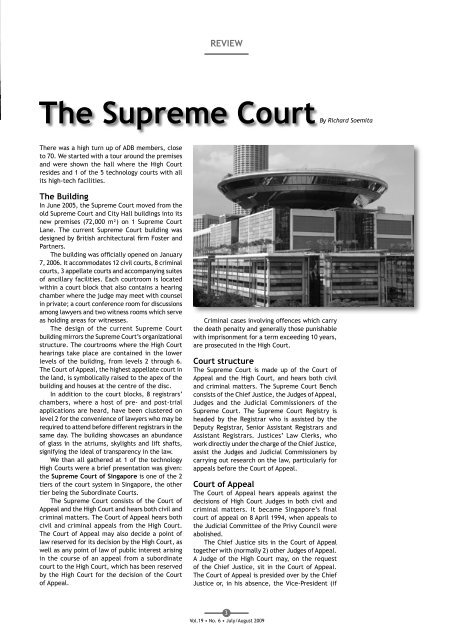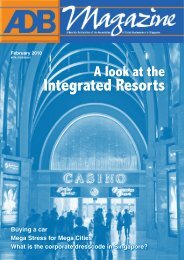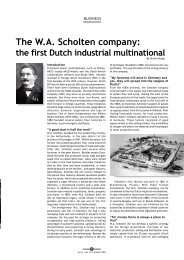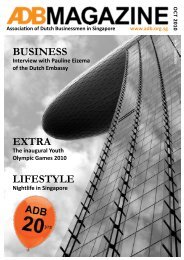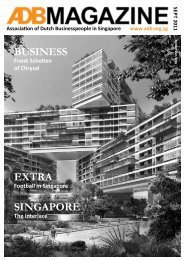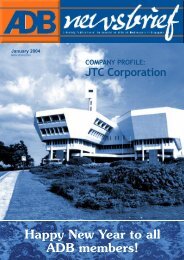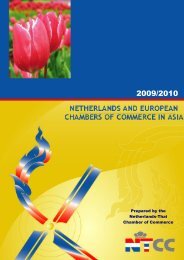July / Augustus 2009 - Association of Dutch Businessmen
July / Augustus 2009 - Association of Dutch Businessmen
July / Augustus 2009 - Association of Dutch Businessmen
You also want an ePaper? Increase the reach of your titles
YUMPU automatically turns print PDFs into web optimized ePapers that Google loves.
Review<br />
The Supreme Court By Richard Soemita<br />
There was a high turn up <strong>of</strong> ADB members, close<br />
to 70. We started with a tour around the premises<br />
and were shown the hall where the High Court<br />
resides and 1 <strong>of</strong> the 5 technology courts with all<br />
its high-tech facilities.<br />
The Building<br />
In June 2005, the Supreme Court moved from the<br />
old Supreme Court and City Hall buildings into its<br />
new premises (72,000 m²) on 1 Supreme Court<br />
Lane. The current Supreme Court building was<br />
designed by British architectural firm Foster and<br />
Partners.<br />
The building was <strong>of</strong>ficially opened on January<br />
7, 2006. It accommodates 12 civil courts, 8 criminal<br />
courts, 3 appellate courts and accompanying suites<br />
<strong>of</strong> ancillary facilities. Each courtroom is located<br />
within a court block that also contains a hearing<br />
chamber where the judge may meet with counsel<br />
in private; a court conference room for discussions<br />
among lawyers and two witness rooms which serve<br />
as holding areas for witnesses.<br />
The design <strong>of</strong> the current Supreme Court<br />
building mirrors the Supreme Court’s organizational<br />
structure. The courtrooms where the High Court<br />
hearings take place are contained in the lower<br />
levels <strong>of</strong> the building, from levels 2 through 6.<br />
The Court <strong>of</strong> Appeal, the highest appellate court in<br />
the land, is symbolically raised to the apex <strong>of</strong> the<br />
building and houses at the centre <strong>of</strong> the disc.<br />
In addition to the court blocks, 8 registrars’<br />
chambers, where a host <strong>of</strong> pre- and post-trial<br />
applications are heard, have been clustered on<br />
level 2 for the convenience <strong>of</strong> lawyers who may be<br />
required to attend before different registrars in the<br />
same day. The building showcases an abundance<br />
<strong>of</strong> glass in the atriums, skylights and lift shafts,<br />
signifying the ideal <strong>of</strong> transparency in the law.<br />
We than all gathered at 1 <strong>of</strong> the technology<br />
High Courts were a brief presentation was given:<br />
the Supreme Court <strong>of</strong> Singapore is one <strong>of</strong> the 2<br />
tiers <strong>of</strong> the court system in Singapore, the other<br />
tier being the Subordinate Courts.<br />
The Supreme Court consists <strong>of</strong> the Court <strong>of</strong><br />
Appeal and the High Court and hears both civil and<br />
criminal matters. The Court <strong>of</strong> Appeal hears both<br />
civil and criminal appeals from the High Court.<br />
The Court <strong>of</strong> Appeal may also decide a point <strong>of</strong><br />
law reserved for its decision by the High Court, as<br />
well as any point <strong>of</strong> law <strong>of</strong> public interest arising<br />
in the course <strong>of</strong> an appeal from a subordinate<br />
court to the High Court, which has been reserved<br />
by the High Court for the decision <strong>of</strong> the Court<br />
<strong>of</strong> Appeal.<br />
Criminal cases involving <strong>of</strong>fences which carry<br />
the death penalty and generally those punishable<br />
with imprisonment for a term exceeding 10 years,<br />
are prosecuted in the High Court.<br />
Court structure<br />
The Supreme Court is made up <strong>of</strong> the Court <strong>of</strong><br />
Appeal and the High Court, and hears both civil<br />
and criminal matters. The Supreme Court Bench<br />
consists <strong>of</strong> the Chief Justice, the Judges <strong>of</strong> Appeal,<br />
Judges and the Judicial Commissioners <strong>of</strong> the<br />
Supreme Court. The Supreme Court Registry is<br />
headed by the Registrar who is assisted by the<br />
Deputy Registrar, Senior Assistant Registrars and<br />
Assistant Registrars. Justices’ Law Clerks, who<br />
work directly under the charge <strong>of</strong> the Chief Justice,<br />
assist the Judges and Judicial Commissioners by<br />
carrying out research on the law, particularly for<br />
appeals before the Court <strong>of</strong> Appeal.<br />
Court <strong>of</strong> Appeal<br />
The Court <strong>of</strong> Appeal hears appeals against the<br />
decisions <strong>of</strong> High Court Judges in both civil and<br />
criminal matters. It became Singapore’s final<br />
court <strong>of</strong> appeal on 8 April 1994, when appeals to<br />
the Judicial Committee <strong>of</strong> the Privy Council were<br />
abolished.<br />
The Chief Justice sits in the Court <strong>of</strong> Appeal<br />
together with (normally 2) other Judges <strong>of</strong> Appeal.<br />
A Judge <strong>of</strong> the High Court may, on the request<br />
<strong>of</strong> the Chief Justice, sit in the Court <strong>of</strong> Appeal.<br />
The Court <strong>of</strong> Appeal is presided over by the Chief<br />
Justice or, in his absence, the Vice-President (if<br />
<br />
Vol.19 • No. 6 • <strong>July</strong>/August <strong>2009</strong>


